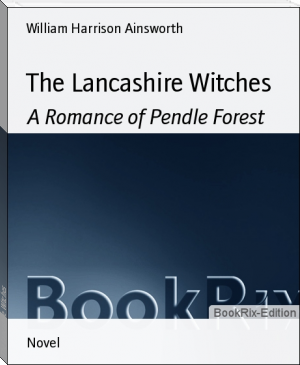The Lancashire Witches: A Romance of Pendle Forest by William Harrison Ainsworth (old books to read .txt) 📖

- Author: William Harrison Ainsworth
Book online «The Lancashire Witches: A Romance of Pendle Forest by William Harrison Ainsworth (old books to read .txt) 📖». Author William Harrison Ainsworth

Nicholas Assheton and the Three Doll Wangos Leaving Hoghton Hall.
THE LANCASHIRE WITCHES. A Romance of Pendle Forest. By William Harrison Ainsworth, Esq.
Sir Jeffery.—Is there a justice in Lancashire has so much skill in witches as I have? Nay, I'll speak a proud word; you shall turn me loose against any Witch-finder in Europe. I'd make an ass of Hopkins if he were alive.—Shadwell.
(of Manchester,) President of the Chetham Society,
And the Learned Editor Of
"The Discoverie of Witches in the County of Lancaster,"— The groundwork of the following pages,—
This Romance,
undertaken at his suggestion,
is inscribed
by his old, and sincerely attached friend,
The Author. CONTENTS.
INTRODUCTION. The Last Abbot of Whalley Chapter I. The Beacon on Pendle Hill. Chapter II. The Eruption. Chapter III. Whalley Abbey. Chapter IV. The Malediction. Chapter V. The Midnight Mass. Chapter VI. Teter et Fortis Carcer. Chapter VII. The Abbey Mill. Chapter VIII. The Executioner. Chapter IX. Wiswall Hall. Chapter X. The Holehouses.
BOOK THE FIRST. Alizon Device Chapter I. The May Queen. Chapter II. The Black Cat and the White Dove. Chapter III. The Asshetons. Chapter IV. Alice Nutter. Chapter V. Mother Chattox. Chapter VI. The Ordeal by Swimming. Chapter VII. The Ruined Conventual Church. Chapter VIII. The Revelation. Chapter IX. The Two Portraits in the Banqueting-Hall. Chapter X. The Nocturnal Meeting.
BOOK THE SECOND. Pendle Forest Chapter I. Flint. Chapter II. Read Hall. Chapter III. The Boggart's Glen. Chapter IV. The Reeve of the Forest. Chapter V. Bess's o' th' Booth. Chapter VI. The Temptation. Chapter VII. The Perambulation of the Boundaries. Chapter VIII. Rough Lee. Chapter IX. How Rough Lee was defended by Nicholas. Chapter X. Roger Nowell and his Double. Chapter XI. Mother Demdike. Chapter XII. The Mysteries of Malkin Tower. Chapter XIII. The Two Familiars. Chapter XIV. How Rough Lee was again Besieged. Chapter XV. The Phantom Monk. Chapter XVI. One O'Clock! Chapter XVII. How the Beacon Fire was Extinguished.
BOOK THE THIRD. Hoghton Tower Chapter I. Downham Manor-House. Chapter II. The Penitent's Retreat. Chapter III. Middleton Hall. Chapter IV. The Gorge of Cliviger. Chapter V. The End of Malkin Tower. Chapter VI. Hoghton Tower. Chapter VII. The Royal Declaration concerning Lawful
Sports on the Sunday. Chapter VIII. How King James Hunted the Hart and the
Wild-Boar in Houghton Park. Chapter IX. The Banquet. Chapter X. Evening Entertainments. Chapter XI. Fatality. Chapter XII. The Last Hour. Chapter XIII. The Masque of Death. Chapter XIV. "One Grave." Chapter XV. Lancaster Castle.
ILLUSTRATIONS. Nicholas Assheton and the Three Doll Wangos
Leaving Hoghton Hall. Alvetham and John Paslew. The May Queen. Nan Redferne and Mother Chattox. Mother Chattox, Alizon, and Dorothy. Alizon Alarmed at the Appearance of Mrs. Nutter. The Incantation. Potts after Being Thrown from his Horse. Richard Overhears the Mother Chattox and the Sexton. The Ride through the Murky Air. The Phantom Monk. Alizon Defies Jennet.
There were eight watchers by the beacon on Pendle Hill in Lancashire. Two were stationed on either side of the north-eastern extremity of the mountain. One looked over the castled heights of Clithero; the woody eminences of Bowland; the bleak ridges of Thornley; the broad moors of Bleasdale; the Trough of Bolland, and Wolf Crag; and even brought within his ken the black fells overhanging Lancaster. The other tracked the stream called Pendle Water, almost from its source amid the neighbouring hills, and followed its windings through the leafless forest, until it united its waters to those of the Calder, and swept on in swifter and clearer current, to wash the base of Whalley Abbey. But the watcher's survey did not stop here. Noting the sharp spire of Burnley Church, relieved against the rounded masses of timber constituting Townley Park; as well as the entrance of the gloomy mountain gorge, known as the Grange of Cliviger; his far-reaching gaze passed over Todmorden, and settled upon the distant summits of Blackstone Edge.
Dreary was the prospect on all sides. Black moor, bleak fell, straggling forest, intersected with sullen streams as black as ink, with here and there a small tarn, or moss-pool, with waters of the same hue—these constituted the chief features of the scene. The whole district was barren and thinly-populated. Of towns, only Clithero, Colne, and Burnley—the latter little more than a village—were in view. In the valleys there were a few hamlets and scattered cottages, and on the uplands an occasional "booth," as the hut of the herdsman was termed; but of more important mansions there were only six, as Merley, Twistleton, Alcancoats, Saxfeld, Ightenhill, and Gawthorpe. The "vaccaries" for the cattle, of which the herdsmen had the care, and the "lawnds," or parks within the forest, appertaining to some of the halls before mentioned, offered the only evidences of cultivation. All else was heathy waste, morass, and wood.
Still, in the eye of the sportsman—and the Lancashire gentlemen of the sixteenth century were keen lovers of sport—the country had a strong interest. Pendle forest abounded with game. Grouse, plover, and bittern were found upon its moors; woodcock and snipe on its marshes; mallard, teal, and widgeon upon its pools. In its chases ranged herds of deer, protected by the terrible forest-laws, then in full force: and the hardier huntsman might follow the wolf to his lair in the mountains; might spear the boar in the oaken glades, or the otter on the river's brink; might unearth the badger or the fox, or smite the fierce cat-a-mountain with a quarrel from his bow. A nobler victim sometimes, also, awaited him in the shape of a wild mountain bull, a denizen of the forest, and a remnant of the herds that had once browsed upon the hills, but which had almost all been captured, and removed to stock the park of the Abbot of Whalley. The streams and pools were full of fish: the stately heron frequented the meres; and on the craggy heights built the kite, the falcon, and the kingly eagle.
There were eight watchers by the beacon. Two stood apart from the others, looking to the right and the left of the hill. Both were armed with swords and arquebuses, and wore steel caps and coats of buff. Their sleeves were embroidered with the five wounds of Christ, encircling the name of Jesus—the badge of the Pilgrimage of Grace. Between them, on the verge of the mountain, was planted a great banner, displaying a silver cross, the chalice, and the Host, together with an ecclesiastical figure, but wearing a helmet instead of a mitre, and holding a sword in place of a crosier, with the unoccupied hand pointing to the two towers of a monastic structure, as if to intimate that he was armed for its defence. This figure, as the device beneath it showed, represented John Paslew, Abbot of Whalley, or, as he styled himself in his military capacity, Earl of Poverty.
There were eight watchers by the beacon. Two have been described. Of the other six, two were stout herdsmen carrying crooks, and holding a couple of mules, and a richly-caparisoned war-horse by the bridle. Near them stood a broad-shouldered, athletic young man, with the fresh complexion, curling brown hair, light eyes, and open Saxon countenance, best seen in his native county of Lancaster. He wore a Lincoln-green tunic, with a bugle suspended from the shoulder by a silken cord; and a silver plate engraved with the three luces, the ensign of the Abbot of Whalley, hung by a chain from his neck. A hunting knife was in his girdle, and an eagle's plume in his cap, and he leaned upon the but-end of a crossbow, regarding three persons who stood together by a peat fire, on the sheltered side of the beacon. Two of these were elderly men, in the white gowns and scapularies of Cistertian monks, doubtless from Whalley, as the abbey belonged to that order. The third and last, and evidently their superior, was a tall man in a riding dress, wrapped in a long mantle of black velvet, trimmed with minever, and displaying the same badges as those upon the sleeves of the sentinels, only wrought in richer material. His features were strongly marked and stern, and bore traces of age; but his eye was bright, and his carriage erect and dignified.
The beacon, near which the watchers stood, consisted of a vast pile of logs of timber, heaped upon a circular range of stones, with openings to admit air, and having the centre filled with fagots, and other quickly combustible materials. Torches were placed near at hand, so that the pile could be lighted on the instant.
The watch was held one afternoon at the latter end of November, 1536. In that year had arisen a formidable rebellion in the northern counties of England, the members of which, while engaging to respect the person of the king, Henry VIII., and his issue, bound themselves by solemn oath to accomplish the restoration of Papal supremacy throughout the realm, and the restitution of religious establishments and lands to their late ejected possessors. They bound themselves, also, to punish the enemies of the Romish church, and suppress heresy. From its religious character the insurrection assumed
 Have you ever thought about what fiction is? Probably, such a question may seem surprising: and so everything is clear. Every person throughout his life has to repeatedly create the works he needs for specific purposes - statements, autobiographies, dictations - using not gypsum or clay, not musical notes, not paints, but just a word. At the same time, almost every person will be very surprised if he is told that he thereby created a work of fiction, which is very different from visual art, music and sculpture making. However, everyone understands that a student's essay or dictation is fundamentally different from novels, short stories, news that are created by professional writers. In the works of professionals there is the most important difference - excogitation. But, oddly enough, in a school literature course, you don’t realize the full power of fiction. So using our website in your free time discover fiction for yourself.
Have you ever thought about what fiction is? Probably, such a question may seem surprising: and so everything is clear. Every person throughout his life has to repeatedly create the works he needs for specific purposes - statements, autobiographies, dictations - using not gypsum or clay, not musical notes, not paints, but just a word. At the same time, almost every person will be very surprised if he is told that he thereby created a work of fiction, which is very different from visual art, music and sculpture making. However, everyone understands that a student's essay or dictation is fundamentally different from novels, short stories, news that are created by professional writers. In the works of professionals there is the most important difference - excogitation. But, oddly enough, in a school literature course, you don’t realize the full power of fiction. So using our website in your free time discover fiction for yourself. 




Comments (0)